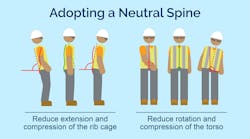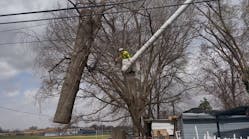Utility vegetation management is a dangerous industry, so preventing injuries in any way possible is paramount. One of the easiest ways we can prevent injuries in the workplace is by using proper ergonomic practices.
The Occupational Safety and Health Association (OSHA) defines ergonomics as the science of designing job tasks to physically fit the worker rather than forcing the worker to make their body fit the job tasks. Since ergonomic injuries are one of the leading work-related hazards, it is important to understand how ergonomics affect job tasks and how to properly complete said tasks. Failure to do so can result in musculoskeletal disorders such as sprains, strains, tendonitis, and lower back injuries.
Practices that Lead to Ergonomic Injuries
There are various ergonomic practices that, when done incorrectly, can lead to injuries. Joints, muscles, tendons, and ligaments are the most susceptible to injury, so it is important to understand how each ergonomic practice can affect these parts of the body.
Heavy, Frequent, and Awkward Lifting. When you bend down to pick up something heavy, it puts great stress on the lower spine, causing pain and muscle fatigue. Additionally, if you carry something and have it resting on one shoulder it can put uneven pressure on one side of the spine which can also cause muscle and back pain.
Repetitive Tasks. When a task is repeated constantly, damage to the muscles, nerves, and tendons can occur. Overuse is a common reason people experience muscle pain, nerve pain, and fatigue.
Awkward Hand Grip. Holding tools incorrectly can put too much pressure and strain on one part of the hand. The excess pressure can cause stress and injury to the tendons and muscles in the hand.
Postures Using Excessive Force. Using a high amount of force creates excessive strain on muscles and tendons, potentially causing strains, sprains, and tears.
Hand-Intensive Work. Overworking the hands is a common occurrence in various fields. Repetitive work on the hands can cause damage to joints, especially when you don’t allow for adequate rest.
How to Prevent Common Injuries?
It is possible to prevent common injuries caused by ergonomic hazards. These precautions include:
- Wearing gloves for repetitive tasks
- Considering the overall weight and configuration of lifted items
- Stopping to get additional assistance when possible
- Using ergonomically designed tools with hand grips
- Switching hands periodically
- Using proper tools and keeping them in good condition
- Stretching to warm up before work and periodically throughout the workday
- Getting adequate rest and maintaining proper hydration
- Ensuring correct posture that uses the legs with a straight back, with no twisting and no bending
Neutral Postures to Prevent Ergonomic Injuries
Making sure your body is in the proper position for certain activities can largely reduce your risk of musculoskeletal injury. Neutral postures align and balance the body and joints to reduce the amount of stress applied to muscles, tendons, nerves, and bones while sitting or standing. Awkward postures are the opposite of neutral postures, moving toward a dangerous range of motion, and are responsible for musculoskeletal injuries.
The Power Zone
The power zone is where you want to be when lifting heavy objects. The zone is close to the body, between the mid-thigh and mid-chest. This is the position in which the arms and back can pick up the most amount of weight with the least amount of effort or strain.
Making sure you are using neutral positions to avoid ergonomic hazards is extremely important in utility vegetation management. Foresters and linemen have to get to some difficult places and may be required to lift heavy equipment or move heavy objects, all of which may strain the musculoskeletal system. Knowing how to position your body during these activities properly can prevent a painful injury from occurring.
M.K. Youngblood serves as the safety manager and tribal liaison at ACRT Pacific. He has more than 30 years of public service and first responder experience with core proficiency in Indian law, Indian culture, and disaster cleanup. Youngblood also serves as a certified instructor for the U.S. Department of Energy (National Nuclear Security Administration and Center for Radiological Nuclear Training), U.S. Emergency Management Institute, and Center for Domestic Preparedness, and as the tribal secretary for the Haslett Basin Holkama Mono Tribe of Fresno County, Calif. For the past 12 years, he has led the California Tribal Emergency Response & Relief Agency (CAL TERRA) as its chief officer of emergency management. Most recently, Youngblood has given presentations for regional safety organizations, developed apprenticeship curricula for use nationwide in cultural conservation and environmental science, and has written peer-reviewed articles for safety in the utility industry. He is currently finishing a special bachelor’s degree at California State University, Fresno in disaster archeology, natural, and cultural resources, with a minor in American Indian studies.


